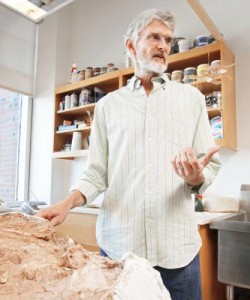New Horned Rodent Fossil Discovered In Museum
Posted by: Loren Coleman on December 28th, 2010

Nick Czaplewski, the Sam Noble museum’s curator of vertebrate paleontology, talks about an ancient horned rodent in Norman, Oklahoma. Czaplewski recently rediscovered the Mylagaulus fossil in storage. Photo by Steve Sisney.
In an article on December 28, 2010, in the Oklahoman, James S. Tyree reveals a startling new discovery fifty years after it should have been made.

Nick Czaplewski, Sam Noble museum curator, shows the cast of the skull of an ancient horned rodent. The remains of a mylagaulus horned rodent found this year in storage at Norman, Oklahoma’s Sam Noble museum appear to be a newly discovered species. Photo by Steve Sisney.

Reconstruction of Ceratogaulus hatcheri, one of the Mylagaulidae or mylagaulids, a prehistoric family of sciuromorph (horned) rodents.
Staff at the Sam Noble Oklahoma Museum of Natural History are excited about the rediscovery of an ancient horned rodent that could turn out to be pure genus.
Remains of a rodent from the mylagaulidae family had been kept in an unmarked plaster-and-burlap “jacket” for 50 years at a Sam Noble museum storage area. Jackets contain sections of earth from archaeological digs.
Nick Czaplewski, the museum’s curator of vertebrate paleontology, said the animal doesn’t seem to fit with any ancient rodent species that had horns. The rodent’s teeth and lower jaw indicate it belonged to a genus and species in the mylagaulus rodent family that up until now was thought to have no horns.
“Well, it has horns for sure,” he said of the discovery, “and that makes it the third or fourth genus in the family that has side-by-side horns on its nose.”
Czaplewski said he and staff members Kyle Davies and Reg Tempelmeyer, are in the process of:Finding out if the mylagaulus is part of some already-named species.
If not, then giving the rodent a name, describing it and explaining why and how it is different from previously known species.
Explaining how the rodent is related to other ones.
“This is the slow and tedious part,” Czaplewski said, “the reading of literature and taking all kinds of measurements.”
Until recently, the fossil’s origin at the museum had been as much a mystery as its origin in nature. Davies brought the unmarked jacket earlier this year from storage to the museum for volunteers and trainees to practice on, which is common.
But Czaplewski said the jacket turned out to contain much of a skeleton and even a skull. “Quite a prize as far as I’m concerned,” he said.
The problem was, the jacket had no location information.
The curator decided to contact David Kitts, the museum’s curator of vertebrate paleontology in the 1950s, to ask about the discovery, only to find the scientist had died Oct. 30.
So Davies brought over some other jackets that could have been associated with the mystery one, and Czaplewski found one that was similar to the one in question — a jacket taken from a western Oklahoma site dated Aug. 16, 1959.
“We found more coincidental evidence tying the jackets to one another and also a date from newspaper lining the plaster and burlap,” Czaplewski said. “I’m pretty confident we now know where the rodent skeleton came from.”Once more is known about the rodent, Czaplewski plans to write and hopefully publish an article on what could be a newly discovered species, and “maybe dedicate the paper to David Kitts, about a half century after he or his helpers collected it.” Source.
About Loren Coleman
Loren Coleman is one of the world’s leading cryptozoologists, some say “the” leading living cryptozoologist. Certainly, he is acknowledged as the current living American researcher and writer who has most popularized cryptozoology in the late 20th and early 21st centuries.
Starting his fieldwork and investigations in 1960, after traveling and trekking extensively in pursuit of cryptozoological mysteries, Coleman began writing to share his experiences in 1969. An honorary member of Ivan T. Sanderson’s Society for the Investigation of the Unexplained in the 1970s, Coleman has been bestowed with similar honorary memberships of the North Idaho College Cryptozoology Club in 1983, and in subsequent years, that of the British Columbia Scientific Cryptozoology Club, CryptoSafari International, and other international organizations. He was also a Life Member and Benefactor of the International Society of Cryptozoology (now-defunct).
Loren Coleman’s daily blog, as a member of the Cryptomundo Team, served as an ongoing avenue of communication for the ever-growing body of cryptozoo news from 2005 through 2013. He returned as an infrequent contributor beginning Halloween week of 2015.
Coleman is the founder in 2003, and current director of the International Cryptozoology Museum in Portland, Maine.










Very cool! That would be crazy to see one of those in person!